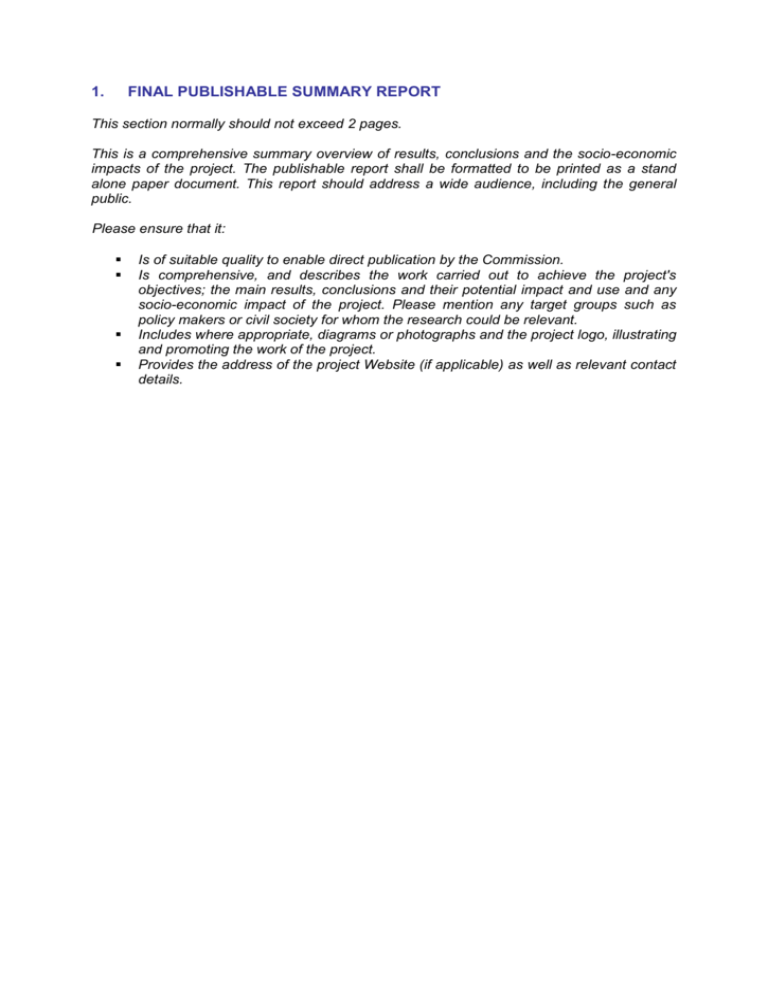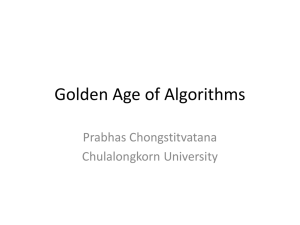43CAQIP (High fidelity quantum gates with trapped
advertisement

1. FINAL PUBLISHABLE SUMMARY REPORT This section normally should not exceed 2 pages. This is a comprehensive summary overview of results, conclusions and the socio-economic impacts of the project. The publishable report shall be formatted to be printed as a stand alone paper document. This report should address a wide audience, including the general public. Please ensure that it: Is of suitable quality to enable direct publication by the Commission. Is comprehensive, and describes the work carried out to achieve the project's objectives; the main results, conclusions and their potential impact and use and any socio-economic impact of the project. Please mention any target groups such as policy makers or civil society for whom the research could be relevant. Includes where appropriate, diagrams or photographs and the project logo, illustrating and promoting the work of the project. Provides the address of the project Website (if applicable) as well as relevant contact details. The discovery that information processing based on the laws of quantum mechanics could be more powerful than its classical counterpart started the field of quantum information processing and led to investigations of the role of information in quantum theory. In quantum information processing, the basic unit of information is a quantum bit or "qubit" comprised of two energy levels. In a quantum bit, information is encoded as superpositions of two basis states. Similar to classical computing, any quantum calculation can be decomposed into a sequence of elementary gate operations consisting of gates that act on single quantum bits and pairs of quantum bits and that coherently transform the quantum state. These gates require coherent coupling between the different qubits, one example being the quantum counterpart to the classical XOR gate, i.e. the quantum controlled-not (CNOT) gate that can be used to entangle two qubits. Trapped ions are a prime candidate for performing quantum information tasks. In these quantum computation schemes, qubits are encoded in long-lived internal states of the ions. The quantum optics and spectroscopy group in Innsbruck led by Prof. Blatt, where the project was carried out, is a leading group in the field of quantum information science in trapped ions. The objective of the research project was to implement high-fidelity quantum gate operations in trapped ions with the purpose of investigating simple quantum algorithms and creating multi-particle entanglement. For this it was proposed to investigate two different ionic species, both isotopes of Ca+. One of these, 43Ca+, offers a qubit system that is immune to magnetic field fluctuations, a prime reason for decoherence in other experiments. Furthermore, a number of laser based operations were proposed to investigate the quality of entangling operations. Figure 1: Ion trap used in project We implemented a two ion entangling gate to produce Bell states with the highest fidelity so far (99.3%) at the start of the project. The gate has also been used on thermal ions, i.e. without ground-state cooling. This result is of key importance for scalable quantum computing, as this generally requires operations that heat up the ion strings. The gate can be readily extended to a larger number of ions and we have investigated schemes with three ions, which open up the possibility of implementing quantum error correction. We also entangled two ions of the isotope 43Ca+ and measured coherence times exceeding the entangling operation by a factor of 103 by encoding in two clock states. The implementation of the high fidelity entangling gate has opened up many possibilities for exciting research. One of the most striking implementation of the entangling gate was a test of quantum contextuallity on trapped ions, which was performed halfway the project. Discussions on whether quantum mechanics can be explained by classical models based on hidden variables date back a long time. A well known property of hidden variable theories that has been tested in experiments is locality. Contextuality is the notion that compatible measurements should have outcomes that do not depend on each other. We tested this property using a pair of trapped ions, while closing the detection loophole. The corresponding scientific paper was published in the journal Nature. Contributions were also made in the flourishing field of quantum simulation. Quantum simulation aims at simulating quantum systems that are experimentally inaccessible and that cannot be simulated efficiently on classical computers, in controlled laboratory systems. A number of simulations were performed involving the motion of the trapped ions, and the researcher was also involved in theoretical work in this field, in collaboration with a theory group in Spain led by Prof. E. Solano and Dr. Garcia-Ripoll. Using trapped ions we performed a quantum simulation of a relativistic particle described by the Dirac equation, based on a proposal by Lamata et al (Phys. Rev. Lett. (2007)). Newly developed measurement techniques allowed us to observe Zitterbewegung and Klein tunneling in the ion dynamics. These peculiar effects in relativistic quantum mechanics were predicted in the 1930s, but have so far eluded direct detection. These experiments resulted in a number of publications, including one in the journal Nature and one in the journal Phys. Rev. Lett., with the researcher as main author. The tools used for these quantum simulations also allowed us to investigate a key quantum mechanical model in the laboratory, the quantum walk, which is the quantum mechanical counterpart of the ubiquitous classical random walk. We were able to derive important properties of the quantum walk in an experimental demonstration resulting in another publication in Phys. Rev. Lett. The results obtained during the project are of importance for developing future platforms for quantum simulation and computation and laid the foundation for future collaborations and experiments at the host institute. The researcher will stay at the host institute for another short period, before leaving to reach a position of independence elsewhere. Further information regarding the experiments done in the quantum optics and spectroscopy group at the host institute can found at: http://www.quantumoptics.at/




